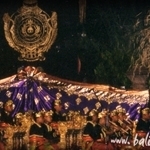Kulkul Bulus di Pekenan Pejeng
A Masterpiece of a New Bali Gamelan Composition (1999)
Composer I Made Sue
Performed by the Group of Gamelan Gong Kebyar "Genta Bhuana Sari (gbs) "

Genta Bhuana Sari at Ardha Candra Open Stage
Bali Arts Festival PKB 1999
Photo Doc. 1999
A few years ago during the Bali Art Festival, I watched one of the main programs, the Dance & Gamelan competition of all the regencies of Bali at Ardha Chandra Open Stage Art Center, Denpasar. During the performance, cheering spectators supporting and appreciating their favorite works kept resounding. Only seldom were any negative comments heard.
In a moment, when the audience quieted down, a man sitting not far away from me said to the people next him, “Do you remember the Kulkul Bulus, which was performed a few years ago?” His interlocutor nodded his head. But a moment later the man who was sitting right in front of him said, “Oh, that work! I also watched that time. The Kulkul Bulus Peken Pejeng, wasn’t it?! It’s already a long time ago. I am glad to remember it, and I still love to hear that work, Sir.”
It is no exaggeration indeed – this is a sincere expression of an ordinary person. Hearing these people speaking about it, I felt my heart suddenly surprised and a sense of pride was revived. It was proud because of the success of that staging by the gamelan Gong Kebyar from Peliatan, Ubud, Gianyar, “Genta Bhuana Sari”, Gianyar Regency’s group representative, who performed the Kulkul Bulus di Pekenan Pejeng and several other works at the Bali Arts Festival (PKB) in 1999.
Almost twelve years have passed, but the “Kulkul Bulus di Pekenan Pejeng” still feels well established in the community of art lovers. It was a new work for the gamelan Gong Kebyar composed by I Made Sue, gamelan teacher from Pejeng village, Tampaksiring, Gianyar. Inspired by a folk song which is known among the people of Bali “ndang ndang dewa ratu kulkul bulus di peken Pejeng”: “ndang-ndang” means “please no more rain”; “dewa ratu” means “oh my god”; “kulkul bulus” (kulkul: Balinese wooden bell) means that the kulkul is to be sounded insistently, which signifies an emergency alert; “peken” means Balinese market; “Pejeng” is the name of a village in Bali, Pejeng village.
These ideas were all translated by I Made Sue into the musical idea behind his new composition, “Kulkul Bulus di Pekenan Pejeng.” This idea is very clearly stated in the composition – rural atmosphere, the noise of wind and rain, and the sound of kulkul bulus. And “peken” or pekenan (traditional market) in this context points to a discussion – questions and answers – between seller and buyer as if it was accompanied by the interaction between one instrument and another in the interlocking style of gamelan music. “Pejeng” describes the atmosphere of the village Pejeng; it is presented in the musical accompaniment to the dance “Barong Landung” that forms part of the composition. This concept is set forth clearly and completely by I Made Sue, resulting in a very beautiful work. Moreover, the folk song “ndang ndang dewa ratu kulkul bulus di Peken Pejeng” is already well known in most communities in Bali, so that through this work people can hear a nostalgic folk songs presented in the form of Gamelan Gong Kebyar.

Genta Bhuana Sari musicians, I Made Suparta & f at Bali Arts Festival PKB 1999
Photo Doc. 1999
For us musicians, it was a privilege to perform a new composition with an original idea in the Bali Arts Festival in 1999. At that time the audiences enthusiastically welcomed this creative performance, and even now the masterpiece “Kulkul Bulus di Pekenan Pejeng” is still embedded in their hearts.
The process of preparation and training was quite short. In April 1999, after the nuasen ceremony (which is performed to start something good), with prayers in the Gunung Sari Temple Peliatan, various intensive exercises began. In each training session the Genta Bhuana Sari’s musicians were trained by I Made Sue and other coaches to expand their musical skills and teach them the discipline and spirit of the artistry needed for this piece. Moreover, various staging experiments were often undertaken. The first staging was produced in the village of Peliatan, in front of the Puri Kaleran Peliatan (Jaba), in a routine staging for tourists.
Despite the limited funds at the time, the spirit of togetherness and the artistic soul of the musicians of Genta Bhuana Sari were deep and sincere. Nor were these qualities separate from the discipline instilled by all the teachers, who wanted strongly to devote themselves to the arts through their works.
Another public performance were presented in June 1999, on Ancak Saji Peliatan Palace and on the stage at the Gianyar Culture Hall, attended by government officials and the public.
On July 8, 1999, it was time to stage the work at the prestigious event on the open stage at the Ardha Chandra Art Centre, Denpasar, as part of the overall presentation of Genta Bhuana Sari at the Bali Arts Festival. The other works featured in this event were Lelambatan Instrumental Pat “Dengkol”, Tari Wiranata, Sandya Gita “Genta Gita Winangun”, and Fragmen Tari “Batur Taskara.” We and our supporters were immensely pleased to be awarded the first place for our performance – it made all the hard work even more worthwhile.
On behalf of all my friends, the musicians of Genta Bhuana Sari Peliatan, greetings and respect to our teachers Mr. I Wayan Djebeg, Mr. I Made Sue, Mr. I Wayan Darya, Mr. Dewa Putu Berata, Mr. Oka Dalem, Mr. I Made Sidia, Mrs. Cok Istri Rukmini, and Mr. I Wayan Wija. Hopefully one day we can get together again and work on another effort to preserve and develop Balinese Art.
Photographs by Rodney Merrill, 1999 & M.H., 1999
Thanks to Mr. Rodney Merrill, U.S.A.
